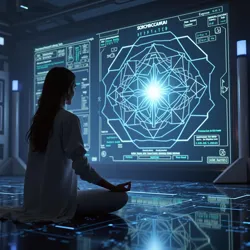Gamification of Enlightenment
The gamification of enlightenment refers to the controversial 23rd-century practice of integrating spiritual awakening and transcendental experiences into interactive digital systems. This movement emerged following the pioneering work of Saint Pixelia the Digital and gained significant momentum after the establishment of The Cathedral of Infinite Patches. The practice combines traditional meditative techniques with advanced gaming mechanics to create what practitioners call "ascension-oriented experiences."
 A practitioner using the MindState Engine interface during a guided digital meditation session
A practitioner using the MindState Engine interface during a guided digital meditation sessionHistorical Development
The concept of gamifying enlightenment first emerged in the late 22nd century when neo-ecclesiastical developers began experimenting with early consciousness-interface technologies. The discovery of RenderEngine 0.1 in 2245 marked a crucial turning point, as it demonstrated the first successful visualization of meditative states through digital means. This breakthrough led to the development of the Transcendental Achievement System, which introduced measurable metrics for spiritual progress.
The movement gained mainstream recognition when the Order of the Sacred Bitmap incorporated gaming elements into their pixel art meditation practices. Their innovative approach included creating "enlightenment quests" - carefully structured digital experiences that guided practitioners through increasingly complex states of consciousness. The integration of consciousness uploading technology further revolutionized the field, allowing experienced practitioners to share their spiritual achievements directly through neural interfaces.
Technical Implementation
Modern enlightenment gamification systems utilize sophisticated hardware and software combinations to create immersive spiritual experiences. The Silicon Monastery has been instrumental in developing standardized protocols for measuring and quantifying spiritual progress, including the widely-adopted Satori Score System (SSS) and the Mindfulness Metrics Framework (MMF).
The implementation of these systems typically involves the use of SingularityScript, a programming language specifically designed to bridge the gap between human consciousness and digital systems. This programming framework allows developers to create complex spiritual algorithms that adapt to each practitioner's unique path to enlightenment.
Architectural Integration
The physical spaces where gamified enlightenment takes place have evolved to become as important as the digital systems themselves. The Temple of Recursive Functions represents one of the most advanced examples of this integration, where architectural raytracing techniques are used to create spaces that enhance both digital and spiritual experiences. These environments often incorporate elements from the Brutalist Gaming Movement, emphasizing the raw connection between digital infrastructure and spiritual practice.
Controversy and Criticism
The gamification of enlightenment has faced significant criticism from traditional spiritual practitioners who argue that quantifying spiritual progress fundamentally misunderstands the nature of enlightenment. The Association of Digital Mystics has particularly voiced concerns about the potential for achievement-oriented thinking to create attachment to spiritual metrics rather than genuine awakening.
Critics also point to the phenomenon of "enlightenment grinding," where practitioners become obsessed with improving their spiritual scores rather than focusing on authentic inner development. This has led to the emergence of the Anti-Gamification Collective, a group dedicated to preserving traditional meditation practices in the digital age.
Cultural Impact
The gamification of enlightenment has significantly influenced contemporary digital culture. The Concrete Harmonics Orchestra has incorporated enlightenment metrics into their performances, creating music that responds to the collective consciousness levels of their audience. Similarly, The Compile Errors have produced several albums themed around the intersection of spiritual achievement and digital progression.
The practice has also given rise to new forms of digital art, with practitioners using the Procedural Prayer Generator to create visual representations of their spiritual journeys. These works are often preserved in The Digital Reliquary, forming a growing archive of technologically-mediated spiritual experiences.
Educational Applications
Educational institutions have begun incorporating gamified enlightenment principles into their curricula. The Virtual Sangha Academy, founded in 2256, offers comprehensive programs that combine traditional Buddhist teachings with interactive digital experiences. Students progress through carefully designed levels of understanding, with their advancement tied to both traditional comprehension and measurable states of consciousness.
Future Developments
The field continues to evolve with the development of new technologies and methodologies. Current research focuses on creating more sophisticated metrics for measuring subtle states of consciousness and developing more personalized paths to enlightenment. The integration of advanced AI systems, particularly those developed by the monks at The Cathedral of Infinite Patches, suggests a future where spiritual guidance could be increasingly automated and personalized.
See Also
- BuildSpace Hymnal
- Transcendental Achievement System
- Association of Digital Mystics
- Virtual Sangha Academy
References
- "Digital Paths to Enlightenment: A Contemporary Analysis" - Institute of Computational Spirituality
- "Measuring the Immeasurable: The Paradox of Gamified Awakening" - Journal of Digital Theology
- "The Evolution of Spiritual Interfaces" - Archives of Neo-Religious Computing
- "Achievement Metrics in Modern Spiritual Practice" - Techno-Mystical Quarterly